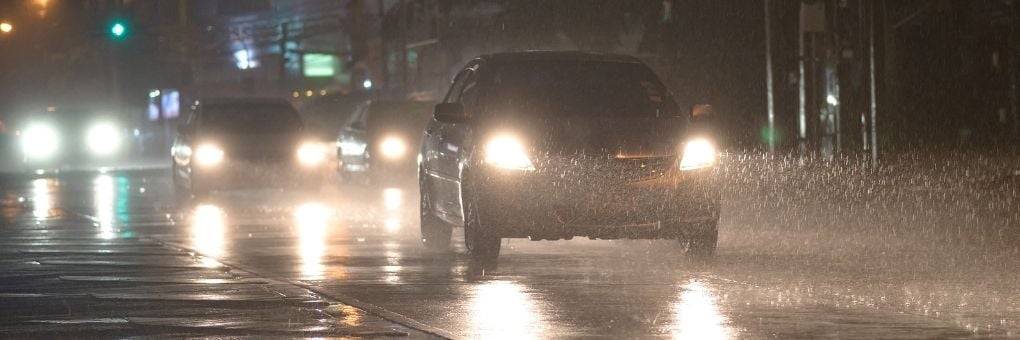How to Apply Good E.I. to Moments of Pressure
From time to time, one of life’s mundane or ordinary tasks or activities will strike me as the perfect analogy for other parts of life. Recently, while traveling from one class to another, it hit me how much driving can provide a great analogy for our daily lives and the emotional intelligence we need to navigate them.
 The moment I thought of this analogy, it had just started to rain, and I was reminded of the law that requires your headlights to be on if your windshield wipers are on in continuous motion. What I find so interesting about this law is the implications is has on our interactions. The law seems to imply that if your view is obstructed by the rain, then you need your headlights on so you can see better. But, almost more importantly, the law seems to also suggest that if someone else’s view is obstructed because of the rain, then your headlights need to be on so they can see you.
The moment I thought of this analogy, it had just started to rain, and I was reminded of the law that requires your headlights to be on if your windshield wipers are on in continuous motion. What I find so interesting about this law is the implications is has on our interactions. The law seems to imply that if your view is obstructed by the rain, then you need your headlights on so you can see better. But, almost more importantly, the law seems to also suggest that if someone else’s view is obstructed because of the rain, then your headlights need to be on so they can see you.
Under prime weather conditions, on a 55mph highway with few hills, likely we don’t need any extra help seeing each other. However, when there are torrential rains, our ability to see each other is compromised. As drivers, we take note, and deliberately and intentionally do something to make it easier and safer for all of us.
 What if we compare moments like these behind the wheel to a moment of stress or pressure? Regardless of the source of our stress or pressure (a lack of time, an abundance of work, and everything in between), in moments like these we’re often not primed to be our best. When we are under pressure, we are often compromised in our ability to build good relationships and interact effectively with others.
What if we compare moments like these behind the wheel to a moment of stress or pressure? Regardless of the source of our stress or pressure (a lack of time, an abundance of work, and everything in between), in moments like these we’re often not primed to be our best. When we are under pressure, we are often compromised in our ability to build good relationships and interact effectively with others.
But what if we applied good emotional intelligence to these moments of pressure? What if we slowed down long enough realize it’s raining, and our windshield wipers are on, and therefore we should also turn on our headlights so others can see? What would it look like? What kind of effects would it have on our work and our relationships?
1. Self-Awareness.
 Let’s start with the first step to emotional intelligence, self-awareness. Whether we recognize it or not, when we start to feel stress or pressure, our bodies start to respond with physical indications. These indications are like the first signs of mist on the windshield, and as we work towards emotional intelligence, it’s important we become aware of them.
Let’s start with the first step to emotional intelligence, self-awareness. Whether we recognize it or not, when we start to feel stress or pressure, our bodies start to respond with physical indications. These indications are like the first signs of mist on the windshield, and as we work towards emotional intelligence, it’s important we become aware of them.
As you become more self-aware, it’s good to watch for the physical manifestations of stress, like a clenched jaw, difficulty sleeping, an inability to focus. It’s also valuable to watch for larger, external factors that could be causing you to feel the pressure, like the three-month busy season where the work tends to pile up, or the last couple days of each month when all the work comes due.
2. Self-Management.
Self-management is acting on the awareness of pressure and stress. It’s doing something about it. But How? Especially in moments of stress, it can be hard enough identifying the source of the pressure; figuring out how to manage it can feel impossible. Try these three simple steps: think, plan, do.
For each of the things that are causing you stress, first start by thinking about them. Not all of them, just one of them. Think about each individual stressor in its entirety and really try to get your arms around it. Once you feel like you’ve got a firm grasp, start to come up with a plan for how you are going to overcome it. Get the details out of your head, write them all out on paper, and use them to help you create a plan. And now all that’s left is to do what you’ve noted you’ll do. Self-management includes taking action, and now that you’ve got a plan in place, you know exactly what you should take action on.
3. Other-Awareness
Our lives largely aren’t lived in isolation. Just as we need headlights to communicate with other drivers on rainy roads, we also need to take steps to communication and interact better with each other under times of stress, and it all starts with Other-Awareness. Other-Awareness, or social-awareness as it’s sometimes called, means learning about others’ likes, dislikes, habits, triggers, and tendencies so that we can have empathy for them and better interactions with them.
Just as self-awareness included looking inward, at our indications of stress, and outward, at the external factors that were causing us stress, the same is true with other-awareness. Even if we know everything there is to know about a person, there will still be larger, external forces at play.
In the same way you might look for other headlights during a rain storm, in times of pressure and stress, remember to look for the triggers that others are working with and use what you know about them to navigate through these difficult waters.
4. Relationship-Management
Relationship management in the analogy of driving might look like the moment we give each other space while we’re driving down a busy highway with the rain falling outside, our windshield wipers on, and our headlights bright.
In the rain, I might slow down and scoot over a bit more than I otherwise would so you can safely pass. In the rain, I might manage myself a bit more to back off my speed, so I don’t end up tailgating you. In the rain, if I am the driver, and you happen to be the pedestrian, I might be really cautious not to splash you as I drive by.
In real life, under times of stress I might give you a little extra grace in our interactions and communications. Under times of pressure, I might give you a little extra room or time to work. In real life, I might work extra hard to manage myself, so I don’t end up splashing you with the fallout of my stress. In real life, it might be as simple as letting each other know when our headlights are on and we’re feeling stressed so we can all respond appropriately. Just as it is with driving in the rain, managing our relationships in time of stress is not difficult. It just requires a little extra thought.
The next time you’re thinking to yourself, “Hey, I’m feeling stressed” use it as an indication to turn on your windshield wipers and manage yourself. Then, turn on your headlights to indicate to those around you what is going on, perhaps how they can help, perhaps what you’re doing about it, perhaps what you can do to help others in this moment. And finally drive responsibly. Navigate through your day in a way that doesn’t cover others with unnecessary puddles.








